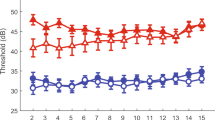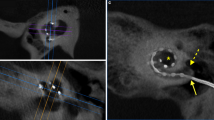Abstract
This study extended the findings of Ketten et al. [Ann. Otol. Rhinol. Laryngol. Suppl. 175:1–16 (1998)] by estimating the three-dimensional (3D) cochlear lengths, electrode array intracochlear insertion depths, and characteristic frequency ranges for 13 more Nucleus-22 implant recipients based on in vivo computed tomography (CT) scans. Array insertion depths were correlated with NU-6 word scores (obtained one year after SPEAK strategy use) by these patients and the 13 who used the SPEAK strategy from the Ketten et al. study. For these 26 patients, the range of cochlear lengths was 29.1–37.4 mm. Array insertion depth range was 11.9–25.9 mm, and array insertion depth estimated from the surgeon's report was 1.14 mm longer than CT-based estimates. Given the assumption that the human hearing range is fixed (20–20,000 Hz) regardless of cochlear length, characteristic frequencies at the most apical electrode (estimated with Greenwood's equation [Greenwood DD (1990) A cochlear frequency–position function of several species–29 years later. J Acoust. Soc. Am. 33: 1344–1356] and a patient-specific constant as) ranged from 308 to 3674 Hz. Patients' NU-6 word scores were significantly correlated with insertion depth as a percentage of total cochlear length (R = 0.452; r2 = 0.204; p = 0.020), suggesting that part of the variability in word recognition across implant recipients can be accounted for by the position of the electrode array in the cochlea. However, NU-6 scores ranged from 4% to 81% correct for patients with array insertion depths between 47% and 68% of total cochlear length. Lower scores appeared related to low spiral ganglion cell survival (e.g., lues), aberrant current paths that produced facial nerve stimulation by apical electrodes (i.e., otosclerosis), central auditory processing difficulty, below-average verbal abilities, and early Alzheimer's disease. Higher scores appeared related to patients' high-average to above-average verbal abilities. Because most patients' scores increased with SPEAK use, it is hypothesized that they accommodated to the shift in frequency of incoming sound to a higher pitch percept with the implant than would normally be perceived acoustically.
Similar content being viewed by others
Author information
Authors and Affiliations
Rights and permissions
About this article
Cite this article
Skinner, M., Ketten, D., Holden, L. et al. CT-Derived Estimation of Cochlear Morphology and Electrode Array Position in Relation to Word Recognition in Nucleus-22 Recipients. JARO 3, 332–350 (2002). https://doi.org/10.1007/s101620020013
Received:
Accepted:
Published:
Issue Date:
DOI: https://doi.org/10.1007/s101620020013




